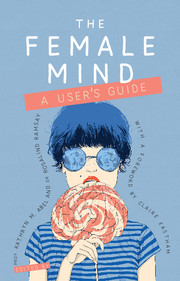Book contents
- Frontmatter
- Acknowledgements
- Contents
- Foreword
- Introduction: being female
- Part I Women in perspective
- Part II Women and society
- Part III Women and their environment
- Part IV Women and specific disorders
- 18 Depression and other mood disorders
- 19 Anxiety disorders
- 20 Trauma and post-traumatic stress disorder
- 21 The dangers of rumination
- 22 Obsessive–compulsive disorder
- 23 Eating disorders and body dysmorphic disorder
- 24 Psychosexual disorders
- 25 Personality disorders: risks and recovery
- 26 Self-harm
- 27 Women and addiction
- 28 Autism spectrum disorder
- 29 Attention-deficit hyperactivity disorder
- 30 Psychotic illness
- 31 Postnatal depression and postpartum psychosis
- 32 Living longer: normal age-related changes, dementia and depression
- Part V Women and treatment
- Contributors
- Index
23 - Eating disorders and body dysmorphic disorder
from Part IV - Women and specific disorders
Published online by Cambridge University Press: 02 January 2018
- Frontmatter
- Acknowledgements
- Contents
- Foreword
- Introduction: being female
- Part I Women in perspective
- Part II Women and society
- Part III Women and their environment
- Part IV Women and specific disorders
- 18 Depression and other mood disorders
- 19 Anxiety disorders
- 20 Trauma and post-traumatic stress disorder
- 21 The dangers of rumination
- 22 Obsessive–compulsive disorder
- 23 Eating disorders and body dysmorphic disorder
- 24 Psychosexual disorders
- 25 Personality disorders: risks and recovery
- 26 Self-harm
- 27 Women and addiction
- 28 Autism spectrum disorder
- 29 Attention-deficit hyperactivity disorder
- 30 Psychotic illness
- 31 Postnatal depression and postpartum psychosis
- 32 Living longer: normal age-related changes, dementia and depression
- Part V Women and treatment
- Contributors
- Index
Summary
‘Who wants to recover? It took me years to get that tiny. I wasn't sick; I was strong.’
– Laurie Halse Anderson (2011)Jo's story
Looking back, I didn't think I was ill at the start. I felt in control and I felt good because I was thin, which made me feel strong and successful. Aren't all successful women thin and beautiful?
That was when I was 15 years old; at 19, I know that none of that is true. I did have an illness, a real illness that hit me in secondary school, preparing for important exams while also breaking up with my first boyfriend.
I thought I wasn't beautiful enough for him and the breakup meant that I also lost my peer group at the time. I felt alone, under pressure and hated myself. I started to diet, like most people do, and joined the gym. I started getting results, which for me was important, in the same way exams were. I lost weight and saw this as positive, so I began to do more exercise, eat less and stopped eating sugary and fatty foods. I didn't see my headaches and dizziness as a problem, I just thought I needed to sleep more. But eventually I wasn't sleeping and my grades began to drop. I felt tired and low and remember sometimes having thoughts that I no longer wanted to live.
I didn't understand why my parents were anxious and arguing with each other about me. They could see something was wrong but I couldn't see it; they tried to talk to me but I couldn't hear them. When I fainted, I was taken to hospital, and this was when I accepted and started treatment with a specialist eating disorder team, who became almost part of our family. They gave not only me much needed support but also the whole family.
My message to you all is that there is hope and you can get help. Don't delay, share your concerns, get the treatment and don't let this illness steal your life.
Eating disorders
Self-starvation in women is not a modern phenomenon. Medieval women in the 13th century believed it would lead to sainthood, sometimes referred to as ‘anorexia mirabilis’.
- Type
- Chapter
- Information
- The Female MindUser's Guide, pp. 146 - 154Publisher: Royal College of PsychiatristsPrint publication year: 2017



